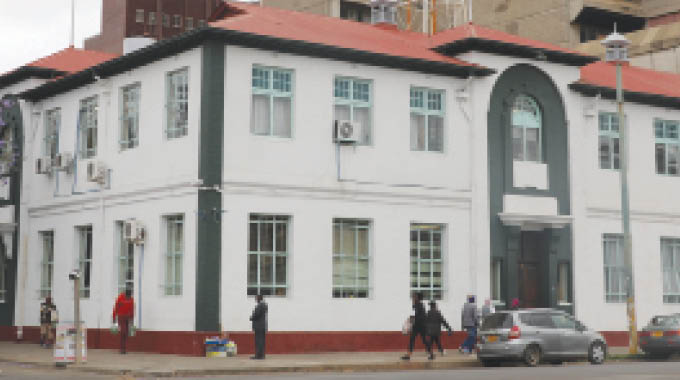The Chronicle: From humble beginnings

Yoliswa Dube-Moyo
ON a Saturday evening 125 years ago, The Chronicle appeared on the dusty streets of Bulawayo for the first time. In keeping with general newspaper style, the front page was made up entirely of advertisements and there were four pages of eight columns each.
The price of this publication was sixpence and the name was proudly displayed on the masthead as The Bulawayo Chronicle.
The date was October 12, 1894.
This was the humble beginning of what today has become one of the most widely read and revered newspapers in the country.
Even in the beginning, The Chronicle was ahead of its rivals as it was a printed news-paper right from its birth, unlike most newspapers which started off as handwritten cyclostyled sheets, including its sister paper The Herald.
Although The Chronicle was produced only months after Lobengula’s capital had been occupied and the flag raised for the first time, it was not the first newspaper to hit the streets of Bulawayo. The distinction belongs to The Matabele Times and Mining Journal, a cyclostyled production which first appeared on March 23, 1894.
That publication was followed in turn by The Matabeleland News and The Chronicle. After The Chronicle, a plethora of other newspapers followed — The Bulawayo Sketch, The Bulawayo Observer, The Licensed Victuallers’ Gazette and shortly afterwards Meph, short for Mephistopheles. As time passed, all these newspapers with their strange names disappeared leaving The Chronicle.
At the helm of The Chronicle in the beginning was an English-born Irishman, John Williams Howard and the first Editor was F.J Summers. In his first editorial comment he wrote: “Bulawayo, long the centre of unspeakable crimes against humanity, has already taken its place as one of the brightest spots in a civilised and virile state, and the journal which makes its first appearance today is launched with abundant confidence in the future of the country whose fortunes it must plough.”
At first, The Chronicle came out weekly in the evenings. In 1895, The Chronicle was brought out twice weekly and on May 5, 1897, it turned into a daily newspaper.
In becoming a daily newspaper, The Chronicle led The Herald although the latter was three years older. As it turned daily, The Chronicle acquired cable and telegraph service. During the first 10 years, the newspaper faced difficulties with transition from the 19th to the 20th century.
In 1896, the newspaper reported on uprisings, the Jameson Raid and the Boer War. The first illustration appeared on June 19,1897 and the first special edition on June 7, 1899. The first halftone picture was printed in 1907 and it was that of Bishop Glasgow, a well-known figure in early Bulawayo. The first cartoon also appeared about this time and the first crossword puzzle appeared in 1925.
The site of The Chronicle on the corner of 9th Avenue and Rhodes (now George Silundika) Street has never changed since the time of the first building of wood and corrugated iron with a single door and six windows on its avenue frontage.
The first black Editor was Mr Tommy Sithole (now Zimpapers chairman) who was appointed Editor in 1981.
The Chronicle is part of several other newspapers published by Zimpapers including The Herald, Manica Post, Sunday News, Sunday Mail, Umthunywa, Kwayedza, B-Metro, H-Metro and Business Weekly.
The publication has over the years grown and diversified to meet the needs of its diverse readers. It has also aligned itself with current digital trends and as a result publishes online and is present on social media platforms. The Chronicle not only asserts a firm position in Bulawayo and the Matabeleland region in general but also has a firm footing in the Midlands and Masvingo provinces.
The publication’s office in Gweru has over the years been strategic in ensuring news coverage in the Midlands province.
Its geographic location, being at the “heart” of the nation has not only benefited The Chronicle but the entire Zimpapers group.
It has also played a pivotal role in business development as it allows one on one interaction with clients in the area unlike making use of agents.
The Chronicle comprises of various editorial departments which cover a diversity of issues ranging from news, business and features to sports, showbiz and gender.
The publication also works closely with the photographic department, cartoonist, proof readers as well as sub-editors who ensure the lay-out and design of The Chronicle pages are done. Below are brief descriptions of the different editorial departments at The Chronicle.
News
News is the communication of information on current events. The news desk covers an eclectic range of issues such as politics, crime, health and environment.
Features
The features desk focuses on stories of special human interest which are not necessarily closely tied to a recent news event. It focuses on particular people, places, and events, and it goes into great detail regarding concepts and ideas of specific market interest. While the distinction between published features and news is often clear, when approached conceptually there are few hard boundaries between the two. Features can be about any subject, from the fluffiest lifestyle piece to the toughest investigative report.
Sports
The sports desk reports on sporting topics and games. Sports coverage has grown in importance as sport has grown in wealth, power and influence. Sports’ reporting is not as easy as being a fan of sports although there are advantages to understanding a particular sport. Sports reporters are tasked to find the storyline and write the story in a way that brings the reader to the event.
Business
It focuses on a wide variety of economic issues that is financial reporting, capital markets or stock exchange, trade, prices, business development and government policy on business, legal frameworks, investment and labour matters. It also covers different sectors of the economy such as manufacturing, tourism, mining and many others.
Showbiz
Showbiz reporting focuses on a wide range of entertainment news including music, television, theatre, modeling, dance, spoken word and literary arts. It also covers the lives of local celebrities in the entertainment industry.
Sub-Editors
They layout and design the newspapers’ pages by inserting copy, pictures as well as crafting headlines.
Proof Readers
They are responsible for checking the designed pages for grammatical, typos and spelling errors that would have escaped the editing chain. Content plays a very important role so proof readers need to ensure clean copy before the newspaper is printed.
Photographic
Photographers work closely with reporters and are expected to take pictures that accompany reports and those independent from reports which tell a story on their own as well as communicate a meaningful message to the readers.
Cartoons
Cartoonists are responsible for the production of different cartoons from the content that would have been published in the newspaper.












Comments